![]() Add To Cart This Word Template
Add To Cart This Word Template
 Add To Cart Proposal Pack Tech #9
Add To Cart Proposal Pack Tech #9
 Add To Cart Proposal Kit Professional Bundle
Add To Cart Proposal Kit Professional Bundle


Key Takeaways
- One-time License, No Subscriptions: Pay once and use Proposal Kit forever with an up-front price lower than monthly services over time.
- Best Template Flexibility: Start with a proven Drone Delivery in Disaster Area Sample Proposal and customize every section, logo, and color to fit your brand and project scope.
- Instant Access: Download immediately and open the sample proposal right away with no waiting, no onboarding delay.
- Ready-Made Structure: See a complete, real-world example (executive summary, scope, schedule, budget, and more) you can mirror for your project. Get a Proposal Pack or Professional package and use the AI Writer to create custom tailored samples or complete first drafts.
- Fully Editable Documents: Replace text, sections, and branding in minutes - no special software skills required.
- Step-by-Step Help: The Proposal Pack Wizard training mode, documentation, and videos guide you through customizing every section so you do not get stuck.
- Built-In Pricing and Quotes: Automate line-item quotes, totals, and taxes from a database, and insert tables/charts so your pricing is clear and consistent.
- Clear Pricing and Bundles: Choose a single industry pack or the Professional bundle for straightforward options that keep costs predictable as your needs grow.
How to write your Drone Delivery in Disaster Area Proposal
You can create your customized editable variation of this document using Proposal Kit. Follow these steps to get started.
 DOWNLOADABLE, ONE-TIME COST, NO SUBSCRIPTION FEES
DOWNLOADABLE, ONE-TIME COST, NO SUBSCRIPTION FEES
Proposal Pack includes everything you need to get started now
- This sample proposal plus
- Library of all 200 samples
- Library of editable templates
- All templates in this design
- Basic contracts and invoices
- Financial calculators
- Wizard proposal software
- How to Write a Proposal e-books
- Customize with your logo
Screenshots of 4 of 16 pages of this sample
Click the PDF View link above to see more. The complete sample is included in every Proposal Pack and the included Wizard software can build you an editable version in Word that will be in the design theme you purchased. You can purchase a different design theme than the sample is illustrated with.
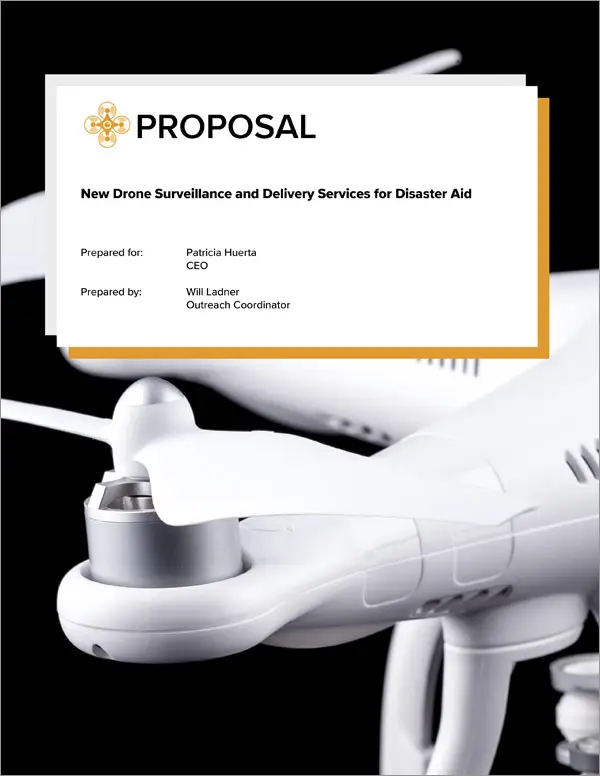
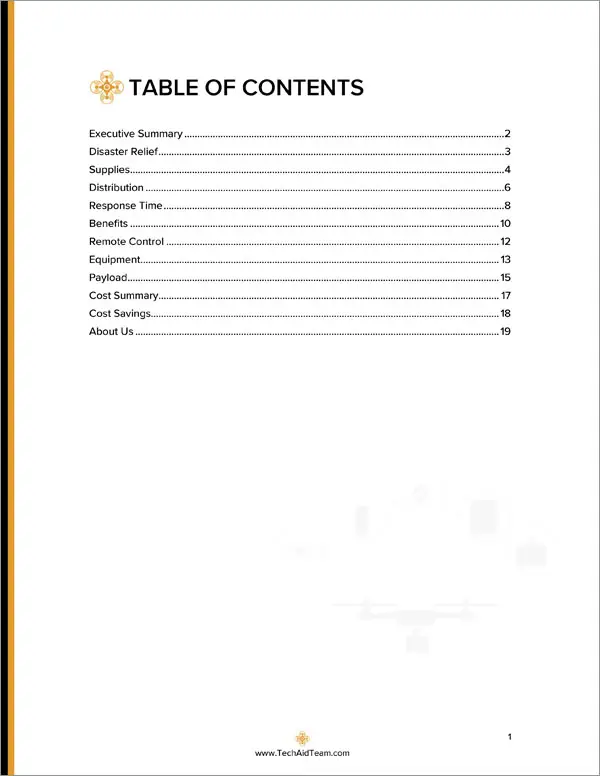
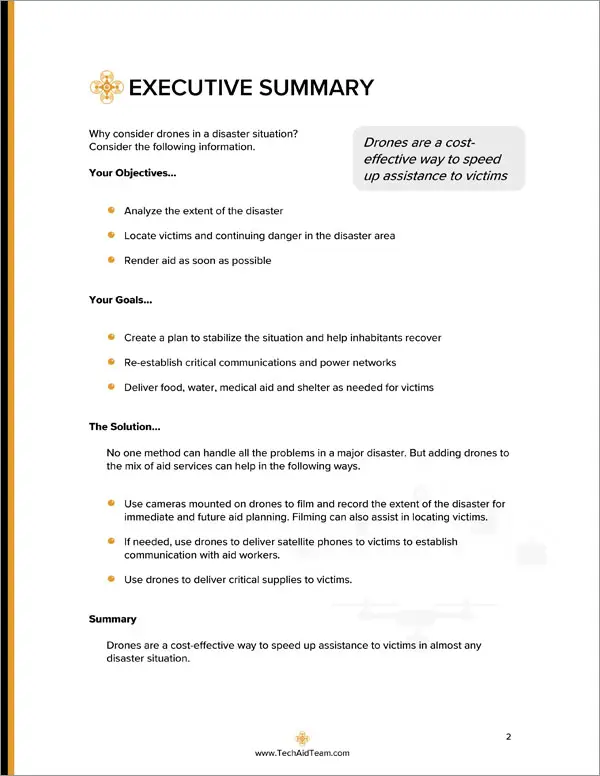
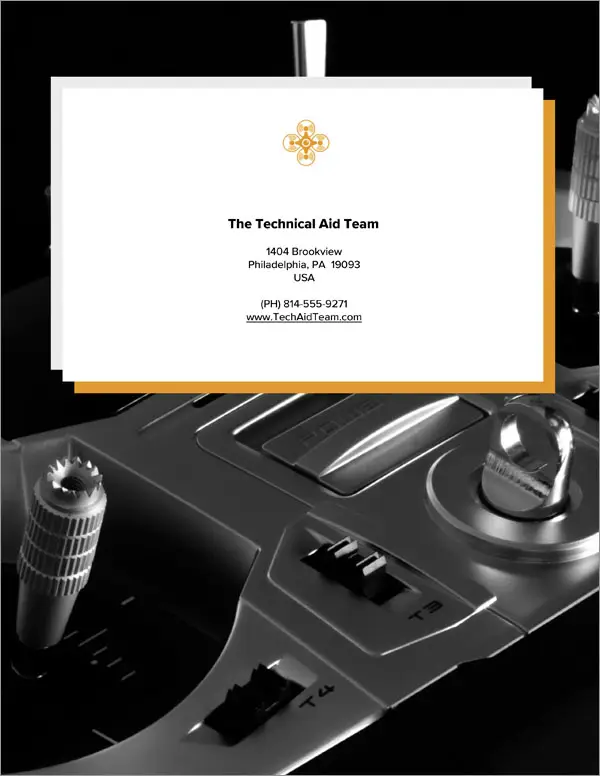
1. Get a Proposal Pack such as Tech #9
This sample was created using the design theme Proposal Pack Tech #9. You can recreate this same sample using any of our Proposal Pack design themes and have it customized for your business.
We include this sample in PDF and editable Word format chapters that can be customized using the included Wizard software when purchased with a Proposal Pack or the Professional Bundle.
To create your customized proposal using your logo and colors, get Proposal Pack for Any Business. We include this sample in every Proposal Pack.
2. Download and install after ordering
Once you have ordered and downloaded your Proposal Pack you will have all the content you need to get started. If you order the sample as a template you will download the Word document after ordering and edit it in your office software.
3. Set up the included Wizard software
While the Wizard software makes the process more efficient, you can manually assemble your version of this sample using the content provided and just a Word processor. We only include the Wizard software with a Proposal Pack or the Professional Bundle.
4. Import the Quick Start layout titled 'Drone Delivery in Disaster Area Sample Proposal'
The included Proposal Pack Wizard software makes creating a customized version of this document speedy and efficient. The sample content is in Word format documents, so you can also use the sample text without using our Wizard software. Using the Wizard software, you can create custom variations of this template and automate your quotes with the line item database.
This is a good example to follow for companies offering products and services in the field.
Anyone pitching combined product and service sales.
5. Customize the template with your information
You can customize the layout with different chapters, change the order of chapters, import your content and information, change the visual design, edit the text, and more. You have complete control over customizing this sample. Use the Wizard's AI Writer to create personalized content specific to your business and project that can be merged with the sample.
Once finished, the AI Writer's Word-to-PowerPoint converter can transform your proposal, business plan, or other business documents into a PowerPoint slideshow.
Abstract
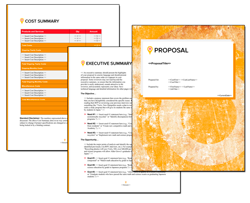
In modern disaster response, integrating drones, also known as unmanned aircraft or unmanned aerial vehicles, is transforming the way organizations deliver disaster relief aid to affected populations. Drone operations provide emergency personnel and first responders with an efficient means to transport packages, deliver medical supplies, and distribute humanitarian aid to disaster-affected areas where ground teams might face hazardous conditions, such as flooding, collapsed infrastructure, or dangerous areas inaccessible by traditional vehicles. The growing importance of drone technology lies in its ability to deliver aid faster, reduce danger to responders, and support the needs of vulnerable communities and residents in the aftermath of natural or man-made disasters.
By using high-resolution cameras and advanced control systems, drones can quickly assess damage, gather data beyond the naked eye, and identify urgent needs, enabling more effective coordination between rescue teams, federal agencies, governments, and other stakeholders. The increased payload capacity of delivery drones allows for more volume and flexibility in the types of resources sent to disaster scenes, which can include food, water, medical kits, communication devices, or shelter materials. Remote pilots and drone operators are responsible for managing compliance with aviation regulations and legislation, ensuring the safe implementation of drone delivery strategies that meet both project requirements and customer expectations.
Drone delivery systems are increasingly recognized for their overall efficiency, cost savings, and ability to expand the reach of health facilities and healthcare providers in isolated or island environments, where traditional logistics may fail. Evaluation metrics and feasibility studies are conducted to demonstrate the effectiveness of drone integration and to address ongoing challenges in environments with limited infrastructure or ongoing hazards. The role of drones in disaster response is not only to strengthen the capacity of emergency responders but also to contribute to the safety and well-being of citizens and residents during critical times.
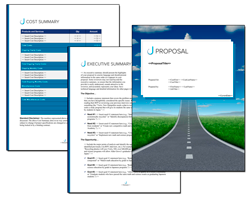
For organizations seeking to act quickly and responsibly in disaster situations, using a disaster area proposal template that supports visual design customization and complex document assembly can streamline the process of developing, submitting, and managing disaster relief projects. Tools like Proposal Kit offer expertise in document management, allowing users to tailor proposals for compliance, funding requests, and stakeholder coordination, while automated quoting and AI Writer features improve efficiency in responding to diverse and urgent needs. Ultimately, the integration of drones and careful planning serves to maintain a rapid and effective response, ensuring that aid is distributed where it is most needed and that the interests of all involved parties are recognized and managed.
Drone operations play an increasingly important role in disaster response, offering innovative solutions to longstanding challenges faced by emergency personnel, firefighters, and health departments in high-risk environments. As remote pilots operate unmanned aerial vehicles beyond the line of sight, these systems allow teams to explore dangerous or inaccessible areas with precision and safety. This approach not only enhances the speed and effectiveness of humanitarian aid but also supports the safety of responders by reducing the need for costly or hazardous missions on the ground.
When evaluating the effectiveness of integrating drones into disaster relief, organizations must consider a range of evaluation metrics, including payload specifications, delivery accuracy, and speed of deployment. Testing and research are crucial for ensuring that proposed drone delivery plans meet both regulatory compliance and operational requirements, with each mission tailored to the specific needs of the affected environment. For example, departments managing disaster relief may convene under the leadership of a president or senior official to assess the advantages of drone integration, using detailed evaluation metrics and real-world testing to inform their strategies.
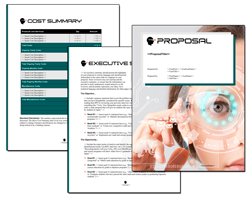
The use of the Proposal Kit enables organizations to efficiently assemble and customize complex proposals outlining the specifications and operational details needed to secure funding or approval. The software streamlines the process of documenting the benefits, compliance measures, and risk mitigation strategies of the proposed drone operations, enabling responders to focus on mission execution rather than paperwork. By empowering organizations to present well-documented, persuasive arguments, these tools help ensure that decision-makers, such as presidents or department heads, fully understand the advantages and expected outcomes of integrating drone technology into their response strategies.
The ability to quickly evaluate, test, and implement drone solutions has the potential to transform disaster response, delivering real-time benefits to affected populations and strengthening the capacity of responders to act decisively when every moment counts.
The integration of unmanned aircraft into disaster response not only enhances logistics and resource allocation but also shapes new strategies for addressing the urgent needs of disaster-affected areas. As organizations increasingly rely on data collected through drone operations, they are able to conduct more thorough evaluations and continuously refine their approaches based on real-world experience and challenges. This capacity to adapt and innovate is especially crucial when serving vulnerable populations and coordinating with various stakeholders under changing conditions.
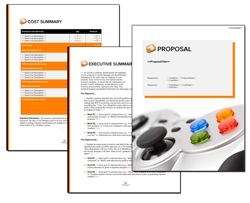
By employing specialized proposal templates and an automated Proposal Kit, responders can document lessons learned and standardize best practices for future incidents, ensuring that every new project builds on the successes and insights of previous missions. The emphasis on compliance, rigorous testing, and detailed specifications further ensures that each deployment meets legislative and regulatory standards, while also taking into account the expectations of customers and the communities served. This careful management of the proposal and implementation process not only supports responsible use of technology but also helps secure ongoing funding and support from governments and federal agencies.
Through the collaborative efforts of ground teams, remote pilots, and decision-makers, the role of drones in disaster relief continues to expand, demonstrating new possibilities for the effective and ethical use of advanced technology in humanitarian contexts. As research progresses and evaluation metrics become more sophisticated, organizations are better equipped to demonstrate the tangible benefits of drone delivery, not just in terms of speed and cost, but in the overall efficiency and resilience of disaster response systems worldwide.
Drone Delivery in Disaster Area Sample Proposal - The Narrative
New Drone Surveillance and Delivery Services for Disaster Aid
Thank you for your organization’s continuing service to disaster victims around the world. Because you have used The Technical Aid Team’s services in crisis situations in the past, we wanted you to know that our services are still available to help re-establish communications and vital computer operations in disaster areas. However, the main reason I am reaching out to you today is to introduce you to an exciting new option we are offering to disaster relief organizations. Drone delivery and surveillance services.
Yes, our technical experts wire and code and assemble technology on the ground, and now we’re using technology in the air, too. As you know, the extent of a disaster can be hard to gauge in the beginning, and often it’s difficult to find victims who need assistance. Drone surveillance can help with that. It’s much cheaper and safer to fly a camera-mounted drone over an area than it is to send a helicopter or a plane.
When disasters cause roads to be impassable, it can be nearly impossible to get needed supplies to victims in a timely fashion. Drones can assist in this effort, too. We hope you find all the information enclosed here to be useful and even inspirational. When you need drones to do the job in a crisis situation, please call on The Technical Aid Team.
While we never look forward to disasters, we look forward to working with your organization in the future. This proposal describes the new drone services available from The Technical Aid Team, which specializes in emergency technical services for disaster situations. Why consider drones in a disaster situation. Consider the following information.
Drones are a cost-effective way to speed up assistance to victims.
Your Objectives
- Analyze the extent of the disaster
- Locate victims and continuing danger in the disaster area
- Render aid as soon as possible
Your Goals
- Create a plan to stabilize the situation and help inhabitants recover
- Re-establish critical communications and power networks
- Deliver food, water, medical aid and shelter as needed for victims
The Solution
No one method can handle all the problems in a major disaster. But adding drones to the mix of aid services can help in the following ways. Use cameras mounted on drones to film and record the extent of the disaster for immediate and future aid planning. Filming can also assist in locating victims.
If needed, use drones to deliver satellite phones to victims to establish communication with aid workers. Use drones to deliver critical supplies to victims.
Summary
Drones are a cost-effective way to speed up assistance to victims in almost any disaster situation. When disaster strikes, time is of the essence. It’s necessary to scope out the situation and get food, water, and medical supplies to victims as quickly as possible.
But often conditions make that task nearly impossible with conventional equipment. Roads may be rendered impassable by natural disasters and landing areas may not be accessible by standard aircraft. Areas affected by violence may be too dangerous to risk the lives of your key personnel.
Heavy-duty drones can lift loads up to 20 kilograms and can be piloted from a safe area. A drone can carry lifesaving supplies for victims, and drones with cameras can aid in search missions to find missing personnel. Drones can be a valuable addition to any disaster relief effort.
The Technical Aid Team has configured the following common relief packages for delivery by our drones. Note that substitutions can be made when weight restrictions allow, and specialized packages may be configured as needed. 40 one-liter plastic bottles of water + powdered supplement packages. An average of 3liters of water per day per person is recommended.
Medical supply kit – Contains a variety of antibiotics, dressings, bandages, pain relievers. Combining this with the surgical kit listed below is often needed for complete medical readiness. Food rations – Contains instant rice and oatmeal, freeze-dried meat and vegetables, vitamin supplements for 10 people for one day.
This package comes in varieties that correspond to religious dietary restrictions. 20 Meals Ready to Eat military issue MREs with flameless heaters included in packages. Each meal contains a main dish and side dishes, and each package contains a flameless device to heat the meal. A variety of menu options is available.
10 heavy synthetic blankets and 20 metallic emergency blankets. Heavy duty blankets are made from synthetic materials to retain warmth in damp conditions as well as washability. 10 satellite cell phones, battery pack chargers, and instructions. When cell towers are down, delivering satellite phones to victims is the fastest way to establish communication.
10 hand-crank radios and 10 hand-crank lights. When no electricity is available, this package can re-establish daily communications and ensure safety after dark. Surgical kit – scalpels, sterile dressings, suture kit, antibiotics, anesthetics, syringes, sterile gloves and masks, IV equipment. This kit may be used for up to five basic surgery procedures.
3 large tents, each suitable for four people. Combine this package with other listed items to create temporary living quarters for victims. 10 cell phone charge battery packs.
In areas where victims are likely to have cell phones but no access to electricity, this package can re-establish communications. Nearly any combination of supplies can be packaged for delivery by our expert staff, as long as total weight of each load does not exceed 20 kilos. For maximum success, each load should be packaged by our staff.
We know how to best protect our payloads and our drones so that packages are delivered with all items intact and usable. See the Payload page for guidance on the size of items that can be packed in our specially configured delivery boxes. Our drones can deliver services worldwide.
Drone drop zones or surveillance destinations must be within a maximum range of up to 20 miles from the drone pilot’s location, and distance may be limited by weather conditions or interference with GPS satellite signals. To activate a drone response team, please call The Technical Aid Team office shown below that is closest to your emergency site.
United States and Canada
Philadelphia, PA office covering the northeast portion of the US and the eastern portion of Canada 555-555-5000. Atlanta, GA office covering southeastern continental US, see Puerto Rico below for U.S. territories in the Caribbean area 555-555-3000. Seattle, WA office covering western U.S., western Canada, and Pacific area 555-555-2000.
International
Puerto Rico office covering Caribbean countries and U.S. territories 555-555-4000. Mexico City office covering Mexico, Central America, and South America 555-555-6000. London, UK office covering Europe 555-555-7000.
Hong Kong office covering Asia 555-555-9000. Nairobi, Kenya office covering Africa 555-555-5500. In many situations, The Technical Aid Team can have an emergency team on-site within thirty hours of notification, assuming that transportation for personnel and equipment is available in a timely manner.
Assembly of drones on-site takes only minutes, and deliveries can often begin within an hour. We can deliver a variety of prepackaged emergency supplies within hours of personnel arrival. Specialized shipments will take longer to assemble and prepare for drone delivery. For most efficient results, call the The Technical Aid Team office closest to the emergency area.
Note the following conditions that may affect response time and drone flying abilities. Major Earthquakes If airports are usable in the affected area, response time can be quick. Earthquakes do not generally affect drone flying abilities.
Tornados, Typhoons, Hurricanes Most aircraft, including drones, cannot fly when storm conditions persist aloft, and our drones must be able to receive satellite signals, so skies cannot be obscured by thick cloud cover. As soon as winds, lightning, and heavy rains pass, our drones can take off on their missions. Emergency Medical Situations When a critical medical problem arises in a remote area, drones are a perfect solution to get equipment and medical supplies to the area as soon as possible.
Drones are particularly effective in situations where victims must be isolated from the general population, such as in an outbreak of contagious disease. Battle Zones Conflict areas and war zones are often too dangerous to send rescue personnel into, but drones can provide surveillance and deliver supplies to trapped victims. Note that there is a greater possibility that drones may be shot down or disabled in some way, but even in the event of capture by hostile forces, enemies do not have the ability to fly the drone without the control panel. In most conditions, a drone response can be activated much more quickly than sending in your valuable personnel.
Utilizing drones for deliveries and surveillance will realize the following benefits for your organization. Drones can deliver supplies and help to analyze the situation while keeping your aid personnel safe. Deliver emergency supplies when roads are impassable Often the biggest problem in an emergency is that the traditional transportation methods are blocked or destroyed.
Drones can deliver supplies when trucks cannot. Inspect disaster areas quickly with onboard cameras It can take days for human crews to be dispatched into a disaster area to examine it from a helicopter or other vehicle. Heavy aircraft and ground vehicles may not be available. Drones can usually survey a disaster area and provide a visual record of the emergency situations more quickly than a helicopter crew can be dispatched.
Films from drones can be easily downloaded to computers for thorough analysis. Protect valuable aid personnel Some situations are just too dangerous to risk the lives and wellbeing of aid workers. Drones can deliver supplies and help to analyze the situation while keeping your aid personnel safe. Re-establish communications In a disaster situation, often victims are totally cut off from communications with organizations that could help.
Drones can deliver cell phones and battery packs, as well as hand-crank radios, to re-establish a communication network in a disaster area. Economy It’s expensive to send personnel and equipment into disaster areas. Drones can often do the job more quickly and economically than human crews can.
Drones will never be able to handle jobs such as debris removal, searching through ruins, or doing surgery on a victim, but adding drones to the array of disaster relief tasks can make operations more efficient and save lives. Each drone relies on a remote control panel guided by a pilot, who may be miles away from the flying drone. When a camera is on board the drone, the pilot can see conditions which the drone is encountering.
In most disaster situations, a camera will be attached to the drone. However, in those rare occasions where a camera is not on board, the pilot must rely solely on GPS coordinates. The following are conditions that may affect control of drones. Interference with satellite GPS signals Our drones rely on global positioning system signals coming from overhead satellites.
If cloud cover is too thick, these signals may be blocked. Weather Like many other types of aircraft, drones can be affected by strong winds, extreme cold, lightning strikes, hail, and other weather problems. In the event of a drone crash, the pilot will receive a signal for later cleanup and retrieval.
Hostile fire A drone may be brought down by gunfire in conflict zones. In the event of a drone crash, the pilot will receive a signal. Note that nobody can operate the drone without the control panel.
Inability to deliver packages Two conditions may prevent a drone from delivering packages. One - no safe landing zone for the package, or Two - malfunction of the grasp and release system. Unsatisfactory locations for pilots Each drone requires a human pilot at the controls. If conditions are unsafe for pilots or if pilots cannot be stationed close enough to fly the drone within the range needed, drones cannot be used.
In most conditions, drones are reliable workhorses that can get certain crucial jobs done more quickly and efficiently than humans can. The Technical Aid Team purchases heavy-duty drones from SkyDragon, and lighter drones from a variety of suppliers. Then we reconfigure them to meet requirements for disaster areas.
Delivery Drones
All delivery drones are heavy-duty drones so they can carry loads of up to 20 kilos. Some of our standard supply packs are described on the Supplies page. Delivery drones can be rigged to deliver packages in two ways.
Package drop via a pulley system while hovering – A retractable cable is attached to a delivery box, which is lowered beneath the drone. The delivery box is released when it touches ground or when a person on the ground presses a button, and then the cable is automatically retracted and stored beneath the drone. This configuration should be used when there is not sufficient clearance to land a drone. Care must be taken so that the cable does not become entangled and so that people on the ground are not injured by dangling cables and delivery boxes.
Package release from landed drone – The drone is configured with a claw mechanism that releases the delivery box on touchdown. When a clear landing area is available, this is the safest way to deliver packages.
Surveillance Drones
Our surveillance drones can be fitted with a variety of cameras, including infrared cameras, to aid in area analysis and location of victims. Depending on the range of flight, the camera to be used, and the estimated time for the flight, we may use a lightweight battery-powered drone or a heavier, longer-range gas-powered drone.
Control panels and laptops
Each drone requires a pilot to monitor position and distance and to maneuver the drone as required for it to complete its mission. For some drones, we use dedicated control panels. For others, we use control applications on laptop computers. Video footage from surveillance drones can be viewed in real time and also recorded for future study.
Repair equipment
Our drone teams always arrive with sufficient spare parts and even spare drones to effect repairs on site. We know that time is of the essence. As previously mentioned in this proposal, our heavy duty drones can carry up to 20 kilograms of supplies and equipment. Payloads must be properly configured for aerodynamics, so it is possible that some items will require disassembly before packaging into a drone payload, and some items are simply not suitable for drone delivery.
Dimensions are determined by the ability of items to fit into the delivery box that will be attached beneath the drone. Maximum weight for release-on-touchdown delivery box. Total items in a release-on-touchdown delivery box cannot weigh more than 42 pounds. The box weighs approximately 2 pounds.
Maximum weight for suspended-cable-release delivery box. Total items in a release-on-touchdown delivery box cannot weigh more than 40 pounds. The box and cable-pulley system together weigh approximately 4 pounds. Due to the slight risks of dropping or crash-landing, explosive items must not be transported, breakable items should be packaged in protective containers, and items that could create a toxic or explosive situation if mixed should not be transported in the same container.
Other considerations
When considering packages for drone delivery, the packager should always consider whether the recipient is likely to have everything needed for use of the items. For example, if cans are included, a can opener should be, too. If rolls of bandaging or cordage or tape are included, the package should also contain scissors or a knife. Instructions should often be included.
The information presented above is current at the time of this writing. Please keep in mind that new drone technology is arriving every day, and The Technical Aid Team will improve our drone fleet and capabilities as the industry evolves. Although it’s impossible to accurately predict in advance what any disaster situation may require, the following table will show you all the expenses you need to consider. Situations may be extremely variable, as some aid organizations may be set up to provide meals and accommodations and even transportation for our pilots, and in other situations The Technical Aid Team will have to purchase all those.
Some crises may require only a few days of our time and services; others may require weeks. We will be happy to provide your organization with a more exact bid when you call to contract for our services. By using drones, your organization can save costs in the following ways. Inexpensive preliminary analysis of disaster scenes It can cost thousands of dollars to fly helicopters or planes over disaster areas to determine the scope of damage and the help needed.
Drones can help with preliminary analysis at much more reasonable costs. Rapid deployment and immediate service Often a needed plane or helicopter must be transported or flown to the disaster area, which results in further expense and a longer wait to help victims. Drones can arrive in the area on any airplane, ship, or ground vehicle, and be flying within hours. Establishing emergency communications Cell phone towers and telephone land lines are often destroyed in natural disasters.
A drone can deliver a pack of satellite cell phones and battery-pack chargers that can immediately establish communication between victims and aid organizations. This can save days of work trying to re-establish damaged networks, and time is money. When possible, satellite phones will be recovered and reused.
Eliminating risk of injury to workers Many disaster scenes are perilous to aid workers, especially those that are in conflict zones. While it’s possible for a drone to crash or even be shot down, the cost of a machine is negligible compared to transporting and treating injured human aid workers. Listed above are just a few of the ways using drones can save your organization money, and get help faster to areas where it is needed.
Drone technology and capabilities will improve rapidly in the coming months and years. We predict that drone services will become standard in disaster zones within three years. The Technical Aid Team is an organization dedicated to delivering technological assistance in emergency situations.
Our teams consist of telecommunications technicians, software programmers, hardware technicians, and now, expert drone mechanics, programmers, and pilots. Our teams are trained to deal with all kinds of disaster situations, from earthquakes and collapsed buildings to tornadoes and hurricanes. We relish the opportunity to help in times of crisis, and we pride ourselves in our ability to get critical systems up and running, and to deliver information and supplies as soon as possible to those who need it. The Technical Aid Team was founded in Philadelphia, PA, but now has regional offices around the world to respond quickly to disasters.
Our offices employ more than 615 managers, technical experts, and support staff. See the Distribution page for a list of offices. Services – Emergency communications and computer system services, and drone surveillance and delivery services.
 What Our Clients Say
What Our Clients SayThe Proposal Pack is an outstanding product, It speeds the proposal process by almost 75%. That adds up to more deals per year. A great growth enabling tool."
Arvato
There are 200 complete sample proposals including this one in each Proposal Pack
The following related samples are also included in Proposal Pack:
These template layouts are related to this sample
The following related templates are also included in Proposal Pack with this sample:
- Drone Mapping and Survey Services Proposal
- Software Automation Proposal
- Industrial Automation Proposal
- Autonomous Vehicle Regulations Proposal
- Robotics Automation Project Proposal
- Artificial Intelligence Project Funding Proposal
- CRM Implementation Proposal Template
- AI Based Matchmaking App Proposal Template
- AI Content Creation For Web Site SEO Proposal Template
- AI Content Moderation Proposal Template
- AI For Environmental Protection Proposal Template
- AI In Agriculture Proposal Template
- AI In Autonomous Vehicles Proposal Template
- AI In Entertainment Personal Recommendations Proposal Template
- AI In Fashion For Trend Forecasting Proposal Template
- AI In Gaming Proposal Template
- AI In Retail Customer Experience Proposal Template
- AI Personal Assistants For Productivity Proposal Template
- AI Relationships Proposal Template
- AI Website Builders Proposal Template
- FinTech Pilot Project Implementation Proposal Template
- FinTech Research and Development Funding Proposal Template
- Marketing Apps Proposal Template
Length of Sample
16 PagesThere are thousands of chapters to choose from in Proposal Pack. This sample uses the following set of Proposal Pack chapter templates: Cover Letter, Title Page, Table of Contents, Executive Summary, Cost Summary, Benefits, Remote Control, Disaster Relief, Response Time, Payload, Supplies, Equipment, Cost Savings, About Us, Distribution, Back Page.
Drone Delivery in Disaster Area Sample Proposal Calculator Spreadheets
These Excel calculator spreadsheets are included with this template. If you purchase a Proposal Pack or the Professional Bundle, these proposal pages are generated using an automated line-item database in the included Wizard software. The calculator spreadsheets are intended for use when purchasing only the sample as a static Word template.
This sample illustrates how to write the following types of proposals
- General business proposal
- Technical proposal
- Product sales proposal
- Service sales proposal
- IT, software, hardware proposal
- Security, safety, protection, investigation proposal
- Military proposal
- Aerospace proposal
- Many other types of proposals
Samples can be created in any Proposal Pack design theme
This sample was created with Proposal Pack Tech #9. To change the visual look purchase any Proposal Pack and this sample will be created in that design theme.
Out of the over 501 Proposal Packs available these designs are also popular for this type of proposal and this sample proposal is also included in every Proposal Pack:
Photo Design Proposal Packs
 Proposal Pack Bullseye #4
Proposal Pack Bullseye #4 Proposal Pack Classic #21
Proposal Pack Classic #21 Proposal Pack Computers #5
Proposal Pack Computers #5 Proposal Pack Computers #7
Proposal Pack Computers #7 Proposal Pack Contemporary #19
Proposal Pack Contemporary #19 Proposal Pack Global #4
Proposal Pack Global #4 Proposal Pack Telecom #4
Proposal Pack Telecom #4Line Art Design Proposal Packs
 Proposal Pack Classic #16
Proposal Pack Classic #16 Proposal Pack In Motion #1
Proposal Pack In Motion #1 Proposal Pack In Motion #2
Proposal Pack In Motion #2 Proposal Pack Tech #1
Proposal Pack Tech #1 Proposal Pack Web #1
Proposal Pack Web #120% Off Discount
![]() Add To Cart This Word Template
Add To Cart This Word Template
 Add To Cart Proposal Pack Tech #9
Add To Cart Proposal Pack Tech #9
 Add To Cart Proposal Kit Professional Bundle
Add To Cart Proposal Kit Professional Bundle
 4.7 stars, based on 849 reviews
4.7 stars, based on 849 reviewsHow to Write a Service Sales Proposal
Demonstration video on how to use Proposal Kit's proposal software to write a proposal to sell services. A basic service sales proposal will include an introduction, information about the services, pricing information and sometimes some specialty information to elaborate on the services such as responsibilities, polices, etc.
Frequently Asked Questions
How do I customize this sample to fit my specific project or business?
If you purchase this sample as a static template, it will be an editable Word format document; otherwise, if you buy a Proposal Pack or the Professional bundle, you can build a more customized editable Word document version of it using the included Wizard software. You can replace the sample information with your own, adjust the text to match your company's tone and style, and modify sections to include project-specific details. The included AI Writer will also customize the content for you.
Can I use multiple sample proposals for different types of projects?
You can purchase multiple samples as individual Word templates or all 200 samples are included in every Proposal Pack and Proposal Kit Professional, which is a much better deal. The Proposal Kit offers sample proposals for various industries and project types. You can select and customize different sample proposals to suit each unique project. This flexibility allows you to create tailored proposals for other clients or projects.
How can I integrate my branding into this sample?
While this sample is an editable Word document, depending on the level of custom branding needed, consider the Proposal Kit Professional, which includes the branding features in the Wizard software that let you create custom-branded design themes more effectively. Start by incorporating your company's logo on the cover page, as well as in the headers and footers of the document. Next, adjust the color scheme of the proposal to match your brand colors. Change the fonts in the proposal to align with your brand's standard fonts. Including branded graphics that reflect your brand's style will further enhance the proposal. Additionally, ensure that the text within the proposal maintains a tone and voice consistent with your brand's communication style. By integrating these elements, your proposal will reinforce your brand identity.
How do I ensure my proposal stands out and wins the client?
To ensure your proposal stands out:
- Personalize the content: Address the client's needs, challenges, and goals to make the proposal unique.
- Highlight your value proposition: Communicate what sets your business apart and how to deliver superior results.
- Use professional design elements: Incorporate visuals, charts, and graphs to enhance the presentation and make it more engaging.
- Proofread and edit: Ensure the proposal is error-free and well-organized. A polished, professional document reflects your attention to detail and professionalism.
What should I do if I need help understanding or modifying a section of this sample?
If you need help understanding or modifying a section of this sample, refer to the detailed instructions provided. Additionally, Proposal Kit includes customer support and resources such as tutorials and videos to assist you. Consulting with a colleague or a professional in your industry can also be beneficial if further clarification is needed. Asking an AI tool can also provide valuable insights for immediate needs. You can load this sample into the Wizard software and let its AI Writer customize the pages for you.
 Ian Lauder has been helping businesses write their proposals and contracts for two decades. Ian is the owner and founder of Proposal Kit, one of the original sources of business proposal and contract software products started in 1997.
Ian Lauder has been helping businesses write their proposals and contracts for two decades. Ian is the owner and founder of Proposal Kit, one of the original sources of business proposal and contract software products started in 1997.By Ian Lauder
 Published by Proposal Kit, Inc.
Published by Proposal Kit, Inc.


 Cart
Cart


 Facebook
Facebook YouTube
YouTube Bluesky
Bluesky Search Site
Search Site